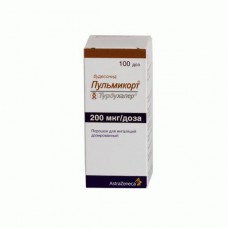Expiration date: 04/2026
The composition and form of issue:
Powder for inhalations dosed. 1 dose contains:
budesonide 100 or 200 mcg
in a plastic inhaler Turbuhaler, consisting of the metering device, a reservoir for storing powder, the container dessicant, mouthpiece and screw-on lids, 100, or 200 doses (for dosage of 200 µg/dose) or 200 doses (dosage 100 µg/dose) in a carton 1 PC
Description pharmaceutical form:
Plastic inhaler 100 mcg/dose — the rotating part of the inhaler is light brown, the underside stamped for 100 BUDESONIDE 200 mcg/dose of the rotating part of the inhaler is the brown color on the bottom side of the embossed BUDESONIDE 200. The inhaler contains round granules from white to almost white, easily crumbling at the slightest mechanical impact. A small part of the substance may be present in powder form.
Indications:
- bronchial asthma requiring maintenance therapy with corticosteroids to control the inflammatory process
- chronic obstructive pulmonary disease (COPD).
Contraindications:
- hypersensitivity to budesonide
- children up to age 6 years.
Caution: when treatment with inhaled corticosteroids in patients with active or inactive forms of pulmonary tuberculosis, fungal, viral or bacterial respiratory infections.
Application of pregnancy and breast-feeding:
Pregnancy. In patients receiving budesonide by pregnant women revealed no increased risk for malformations in the fetus, however, cannot completely eliminate the risk of their development, therefore, during pregnancy, in connection with the possibility of worsening of bronchial asthma, you should use the minimum effective dose of budesonide.
The results of studies on animals have shown that corticosteroids can cause abnormalities of the fetus, but these data cannot be extrapolated to individuals receiving corticosteroids at recommended doses.
Lactation. Data on the penetration of budesonide in breast milk is not available.
In appointing the drug should be balanced against the expected benefit to the mother and the potential risk for the baby.
Side effects:
Up to 10% of patients taking the drug may experience the following side effects:
Frequent (>1/100)
From the respiratory tract, candidiasis of the oropharynx, irritation of throat, cough, hoarseness.
Rare (<1/1000)
General: angioedema.
The skin: urticaria, rash, contact dermatitis.
From the respiratory: bronchospasm.
There may be some neuropsychiatric symptoms such as nervousness, anxiety, depression, behavior disorders. Taking into account the risk of candidiasis of the oropharynx, the patient should thoroughly rinse your mouth with water after each inhalation drug.
In rare cases there can be symptoms caused by a systemic effect of corticosteroids, including adrenal hypofunction.
In rare cases, observed bruising on the skin.
Method of application and dose:
Inhalation. The dose is adjusted individually. Recommended dose in case of inhaled glucocorticoid therapy in severe exacerbations of asthma, as well as on the background dose reduction or withdrawal of oral corticosteroids, the following:
Children older than 6 years of 100-800 µg/day (total daily dose may be divided into 2-4 inhalations). If the recommended dose does not exceed 400 mg/day, the entire dose can be taken 1 time (once).
In children, the transition to a single dose of the drug must be conducted under the supervision of a pediatrician.
Adults — the usual dose is 200-800 mg/day (total daily dose may be divided into 2-4 inhalations). For the treatment of severe exacerbation of asthma, the daily dose may be increased up to 1600 micrograms. If the recommended dose does not exceed 400 mg/day, the entire dose can be taken 1 time (once).
When selecting a maintenance dose, it is necessary to aspire to appointment of the minimum effective dose.
The start time for therapeutic effect after inhalation 1 dose of a few hours. The maximum therapeutic effect is achieved after several weeks of treatment. Pulmicort Turbuhaler has a preventive effect on the course of bronchial asthma and has no effect on the acute manifestations of the disease. Demonstrated better efficacy of budesonide when used Turbuhaler compared to the same dose of budesonide in the form of a metered-dose aerosol. In the event of a transfer of the patient in a stable condition, Pulmicort in aerosol form for Pulmicort Turbuhaler, you should consider lowering the daily dose of budesonide. To enhance the therapeutic effect, we recommend increasing the daily dose of Pulmicort Turbuhaler is the combination of the drug with oral steroids, due to the lower risk of systemic effects.
Patients receiving oral corticosteroids
Discontinuation of oral GCS should be carried out on the background of a stable state of health of the patient. Within 10 days advised to take high dose of Pulmicort in patients receiving oral corticosteroids in a selected dose. Further dose of oral corticosteroids should be gradually reduced (e.g. 2.5 mg prednisolone or equivalent) to the lowest possible level. In many cases it is possible to completely abandon the use of oral corticosteroids.
No data on the use of budesonide in patients with renal insufficiency or impaired liver function. Taking into account the excretion of budesonide due to biotransformation in the liver, one can expect an increase in the duration of action of the drug in patients with severe liver cirrhosis.
Overdose:
An overdose of Pulmicort Turbuhaler in doses, greatly exceeding recommended, of clinical manifestations does not occur. Prolonged use of the drug in doses, greatly exceeding recommended, may develop systemic glucocorticosteroid effect of hypercortisolism and suppression of adrenal function.
Special instructions:
To minimize the risk of fungal lesions of oropharynx, should inform the patient about the need to rinse your mouth thoroughly with water after each inhalation drug.
Avoid joint appointment budesonide with ketoconazole, Itraconazole or other potential CYP3A4 inhibitors. In the case of budesonide and ketoconazole or Itraconazole or other potential inhibitors CYP3A4 was appointed, increase the time between administration of drugs to the maximum possible.
Because of the potential risk of weakening of pituitary-adrenal function special attention should be given to patients who are transferred from oral corticosteroids to receive Pulmicort. Also, special attention should be given to patients taking high-dose corticosteroids, or long-term receiving the highest recommended dose of inhaled corticosteroids. In stressful situations, such patients may manifest the signs and symptoms of adrenal insufficiency. Under stress or in cases of surgical intervention is recommended for more therapy systemic corticosteroids.
Special attention should be given to patients who are transferred from systemic to inhaled corticosteroids (Pulmicort Turbuhaler), or in the case, when can we expect impairment of the pituitary-adrenal function. In such patients, should take special precautions to reduce the dose of systemic corticosteroids and to control the hormonal function of the adrenal glands. Also patients may require the appointment of oral corticosteroids during stressful situations such as trauma, surgery, etc.
When switching from oral corticosteroids to Pulmicort turbuhaler the patients can feel previously observed such symptoms as muscle aches or joint pain. In such cases, you may need a temporary increase in the dose of oral corticosteroids. In rare cases, there may be symptoms such as fatigue, headache, nausea and vomiting, indicating a systemic failure of GKS.
Replacement of oral corticosteroids to inhaled sometimes leads to the manifestation of concomitant allergies (e.g., rhinitis and eczema) which were previously stoped systemic drugs.
In children and adolescents receiving treatment with glucocorticoids (regardless of method of delivery) over an extended period, it is recommended to regularly monitor the growth.
Patients should be instructed to contact the treating physician in the case of reducing the effectiveness of therapy with bronchodilators short-acting, as an independent increase in the frequency of use of the drug may lead to the postponement of the appointment of adequate treatment. In case of a sudden deterioration, you should consider a course of treatment with oral corticosteroids.
Effects on ability to drive or other mechanisms. Turbuhaler pulmicort does not affect the ability to drive or other mechanisms.
Instructions for correct use of Turbuhaler
The drug contained in Turbuhaler gets into the patient's airway with the flow of air when performing active breath through the mouthpiece Turbuhaler.
Attention: it is important to convince the patient to carefully read the instructions for use Pulmicort Turbuhaler.
To be sure that the optimal dose of the drug into the lungs, must be deeply and strongly inhaling through the mouthpiece Turbuhaler.
Under no circumstances do not exhale through the mouthpiece.
After inhalation of the required dose of the drug to rinse your mouth with water in order to minimize the risk of fungal infection of the oropharynx.
Do not use after the expiry date printed on the package.
How to use Pulmicort Turbuhaler
Turbuhaler — multidose inhaler, allow the mixture and inhale the drug in very small doses. When the patient inhales, the powder of Turbuhaler is delivered to the lungs. It is therefore important that the patient strongly and deeply inhaled through the mouthpiece.
Turbuhaler very easy to use. Just follow the instructions below:
1. Unscrew and remove the cap.
2. Keep the inhaler upright, with the spout down. To load in inhaler dose by turning the spout counterclockwise until it stops, and then turn the dispenser to its original position until it clicks.
3. Exhale. Do not exhale through the mouthpiece. Before you exhale, remove inhaler from the mouth.
4. Gently squeeze the mouthpiece with your teeth, compressed lips and breathe deeply and strongly through the mouth. The mouthpiece should not be chewed and strong gripping teeth.
If you want to inhalation of more than one dose, repeat steps 2-5.
5. Close the inhaler cap.
6. Rinse your mouth with water.
IMPORTANT!
Never exhale through the mouthpiece. Always close the inhaler cap after use.
Since the amount of the inhaled powder is very small, the patient may not taste the powder after inhalation. However, if he followed the instructions, you can be sure that inhaled the dose of the drug.
Cleaning
Regularly (once a week) you should clean the mouthpiece on the outside with a dry cloth.
Do not use water or other liquids to clean the mouthpiece.
How to know inhaler empty?
The appearance in the window of the dose indicator red mark means that the inhaler is approximately 20 doses. The inhaler is empty when the red mark reaches the lower edge of the window of the dose indicator.
The sound that you hear when shaking the inhaler is drying agent, not a cure.



